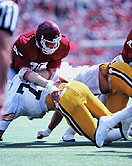
TUESDAY, March 13 (HealthDay News) — Heat-related deaths among high school and college football players in the United States nearly tripled between 1994 and 2009, according to a new study.
An average of nearly three players died each year during that time period — up from about one death per year during the previous 15 years — with six deaths occurring in Georgia alone, the most of any state.
The University of Georgia researchers analyzed weather conditions, along with information on all 58 athletes who died of hyperthermia (overheating) during football practice. Specifically, they examined the temperature, humidity and time of day of the incident, as well as the players’ height, weight and position.
The study, published recently in the International Journal of Biometeorology, found that morning heat indexes were higher from 1994 to 2009 than they were in the preceding 15 years.
“In general, on days the deaths occurred, the temperature was hotter and the air more humid than normal local conditions,” senior study author Andrew Grundstein, a climatologist and associate professor of geography at the University of Georgia, said in a university news release.
More than half of the players got sick on days when practice was held in the morning and ended before noon. Most of the deaths occurred in August, when many coaches intensified preseason training.
Researchers used wet bulb globe temperature, developed by the American College of Sports medicine, which takes into account air temperature, players’ ability to be cooled through evaporation and the amount of solar radiation absorbed by players’ skin. They also used the U.S. National Weather Service’s heat index. The authors noted limitations to the study, however, such as that neither of these methods used to measure temperature account for the added heat caused by football pads and helmets.
“We all want a single magic number to indicate the heat threshold,” Grundstein said. “But so many factors contribute to heat stress that it’s impossible to draw the line at a single temperature.”
The researchers said coaches should take the following steps to avoid heat illness among players:
- Know the true temperature outdoors.
- Make sure players ramp up their workouts slowly over time so they can acclimate to outdoor temperatures.
- Remind trained staff members to watch for signs of hyperthermia among players.
- Have an emergency management plan in place to address heat-related illness immediately.
The researchers said body-mass index (BMI) — a measure of body fat based on height and weight — also could have played a role in the increase in player deaths. The study showed football players have gotten bigger since 1980, which could make them more susceptible to hyperthermia. Of the players who died, 86 percent were linemen, who tend to have a higher BMI than other players.
More information
The U.S. Centers for Disease Control and Prevention provides more information on how to prevent overheating.

